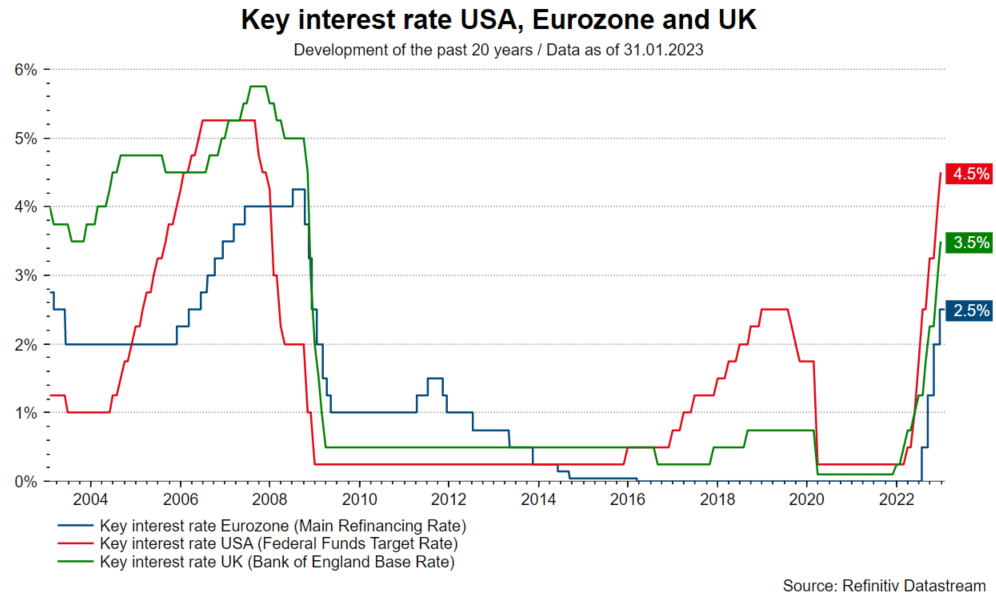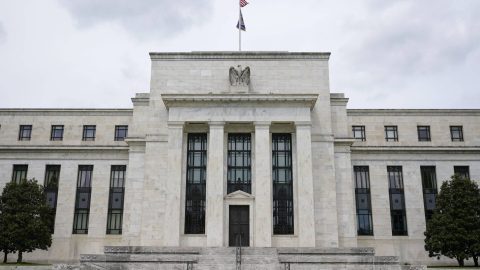In recent days, evidence of a slowdown in real economic growth in the US has increased. This includes immediate risks of recession. The price increases of stocks and bonds since the beginning of the year have been driven by optimism that there could be sustained declines in inflation (disinflation scenario) without the need for weak growth or even a recession (stagnation or recession scenario). In fact, the three scenarios could alternate as a driving factor for the markets.
Hope disinflation scenario
At least the inflation indicators published to date do not contradict the disinflation scenario. This involves a significant and sustained decline in inflation, allowing central banks to phase out the cycle of interest rate hikes in the first half of the year and cut rates in the second half. In the USA, the personal consumption expenditure deflator rose by just 0.1% month-on-month in December. However, the core rate excluding energy and food remained elevated at 0.3% y/y / 4.4% y/y. This week the US central bank will pay close attention to the fourth-quarter labor cost index. The index is the best indicator of wage inflation and significantly influences domestically generated inflationary pressures (in the services sector).
Key interest rate hikes
Three important interest rate decisions are on the calendar in the coming days. For the US Federal Reserve (Fed), the upper band of the key interest rate is expected to rise by 0.25 percentage points to 4.75% next Wednesday. Both the European Central Bank (ECB) and the Bank of England (BoE) are forecast to raise their key interest rates by 0.5 percentage points to 3.0% (main refinancing rate) and 4.0% respectively.

Note: Past performance is not a reliable indicator of future performance.
Sharp central bank rhetoric
It is probably still too early for central banks to tone down the sharp (hawkish) rate hike rhetoric. Uncertainty about the further development of inflation is still too great for them to deviate from data-dependent policy (past-oriented approach). The biggest potential for surprise is located at the Fed. The chairman of the Federal Open Market Committee, Powell, could try to soften the key rate cuts for this year already included in market prices by means of an inflation-fighting choice of words. In contrast, the central bank in Canada last week officially announced a pause in the rate hike cycle as long as the inflation trend is in line with the central bank’s forecasts (forward-looking approach).
Good growth in the USA
The first estimate for real economic growth in the fourth quarter of 2022 showed good growth on the surface of 2.9% quarter-on-quarter (annualized, i.e., actual growth times four) and 1.0% year-on-year. However, the details of GDP were not encouraging.
Core rate
Just as for other economic categories (inflation, debt, interest rates, profits), attempts are made to identify an underlying trend in growth. One simple method is to factor out the components with higher (assumed) fluctuations. In the case of US GDP, the external sector (exports minus imports), government spending and inventory changes are excluded. What remains is private consumption and private investment, referred to as real final sales to domestic purchases.
Low underlying growth
This core rate of GDP growth grew by only 0.2% (annualized) in the fourth quarter. The drivers of growth were outside the core rate. The change in inventories added 1.5 percentage points to the 2.9% GDP growth. However, survey-based indicators suggest an unintended inventory buildup. The inventory change could soon reduce growth. Government spending contributed 0.6 percentage points to growth. The hit of the debt ceiling will likely lead to a reduction. Net exports also contributed 0.6 percentage points to growth. However, this was because imports fell more sharply than exports. Lower imports provide an indication of lower domestic demand. Improving growth prospects for Europe and China could help with exports in the first half of the year, but overall, the external sector accounts for a small share of GDP. Within the core rate, however, the interest rate-sensitive construction sector was again particularly weak. Residential investment subtracted 1.3 percentage points from growth.
For the time being, the central bank will implement a restrictive interest rate policy. Business investment barely grew at all, contributing 0.1 percentage points to growth. The core rate of new orders for durable capital goods, which is used as a leading indicator for investment, contracted by 0.2% month-on-month in December. Although personal consumption grew well on a quarterly average (contribution to growth: 1.4 percentage points), November (-0.2 p.m.) and December (-0.3% p.m.) showed a decline in growth. The question remains how long the labor market will remain strong to support private consumption.
Improved growth prospects for China and Europe and hopes of a sustained decline in inflation have supported the markets since the beginning of the year. However, sharp central bank rhetoric and weak growth indicators in the USA could prove to be spoilers.
For a glossary of technical terms, please visit this link: Fund Glossary | Erste Asset Management
Legal note:
Prognoses are no reliable indicator for future performance.
Legal disclaimer
This document is an advertisement. Unless indicated otherwise, source: Erste Asset Management GmbH. The language of communication of the sales offices is German and the languages of communication of the Management Company also include English.
The prospectus for UCITS funds (including any amendments) is prepared and published in accordance with the provisions of the InvFG 2011 as amended. Information for Investors pursuant to § 21 AIFMG is prepared for the alternative investment funds (AIF) administered by Erste Asset Management GmbH pursuant to the provisions of the AIFMG in conjunction with the InvFG 2011.
The currently valid versions of the prospectus, the Information for Investors pursuant to § 21 AIFMG, and the key information document can be found on the website www.erste-am.com under “Mandatory publications” and can be obtained free of charge by interested investors at the offices of the Management Company and at the offices of the depositary bank. The exact date of the most recent publication of the prospectus, the languages in which the fund prospectus or the Information for Investors pursuant to Art 21 AIFMG and the key information document are available, and any other locations where the documents can be obtained are indicated on the website www.erste-am.com. A summary of the investor rights is available in German and English on the website www.erste-am.com/investor-rights and can also be obtained from the Management Company.
The Management Company can decide to suspend the provisions it has taken for the sale of unit certificates in other countries in accordance with the regulatory requirements.
Note: You are about to purchase a product that may be difficult to understand. We recommend that you read the indicated fund documents before making an investment decision. In addition to the locations listed above, you can obtain these documents free of charge at the offices of the referring Sparkassen bank and the offices of Erste Bank der oesterreichischen Sparkassen AG. You can also access these documents electronically at www.erste-am.com.
Our analyses and conclusions are general in nature and do not take into account the individual characteristics of our investors in terms of earnings, taxation, experience and knowledge, investment objective, financial position, capacity for loss, and risk tolerance. Past performance is not a reliable indicator of the future performance of a fund.
Please note: Investments in securities entail risks in addition to the opportunities presented here. The value of units and their earnings can rise and fall. Changes in exchange rates can also have a positive or negative effect on the value of an investment. For this reason, you may receive less than your originally invested amount when you redeem your units. Persons who are interested in purchasing units in investment funds are advised to read the current fund prospectus(es) and the Information for Investors pursuant to § 21 AIFMG, especially the risk notices they contain, before making an investment decision. If the fund currency is different than the investor’s home currency, changes in the relevant exchange rate can positively or negatively influence the value of the investment and the amount of the costs associated with the fund in the home currency.
We are not permitted to directly or indirectly offer, sell, transfer, or deliver this financial product to natural or legal persons whose place of residence or domicile is located in a country where this is legally prohibited. In this case, we may not provide any product information, either.
Please consult the corresponding information in the fund prospectus and the Information for Investors pursuant to § 21 AIFMG for restrictions on the sale of the fund to American or Russian citizens.
It is expressly noted that this communication does not provide any investment recommendations, but only expresses our current market assessment. Thus, this communication is not a substitute for investment advice.
This document does not represent a sales activity of the Management Company and therefore may not be construed as an offer for the purchase or sale of financial or investment instruments.
Erste Asset Management GmbH is affiliated with the Erste Bank and austrian Sparkassen banks.
Please also read the “Information about us and our securities services” published by your bank.


